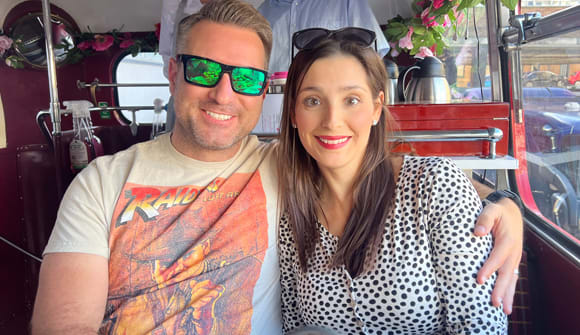A heart in harmony
New procedure delays the need for open-heart surgery.
Article Author: Melissa Seguin
Article Date:

Amanda Tillman, a preventionist with the Infection Prevention team at Baptist Medical Center Jacksonville, is no stranger to the hospital.
“It’s like a second home,” she said. “I’ve been in and out of the hospital my whole life. I’ve been a patient and I’ve worked here for 14 years.”
Born prematurely, Tillman spent a few days in the Neonatal Intensive Care Unit (NICU) at a children’s hospital in Tampa, where she and her family lived at the time. When she was only a few days old, a neonatal nurse noticed her heart didn’t sound quite right. Knowing Tillman’s mother had a history of a congenital (present at birth) heart defect, the NICU nurse called in a pediatric cardiologist who diagnosed Tillman with tetralogy of Fallot. This condition, which is not always genetic, affects blood flow through the heart.
At age 4, right before she started kindergarten, Tillman had her first open-heart surgery to repair her congenital heart defect. In 2023, at age 36, Tillman underwent a brand-new procedure to insert a device to replace her pulmonary valve, which helps blood flow to the lungs. The Harmony Valve™ can be delivered through a catheter, requiring only a small incision. The procedure delays the need for open-heart surgery.
Living with a heart defect
In elementary school, Tillman and her family moved to Jacksonville and started seeing specialists with Wolfson Children’s C. Herman and Mary Virginia Terry Heart Institute, including Robert English, MD, a pediatric interventional cardiologist with Nemours Children’s Health, Jacksonville.
Tillman can see doctors at the Terry Heart Institute for her entire life through the Adult Congenital Heart Program. More children with congenital heart defects are surviving and thriving into adulthood thanks to advances in medical care, and pediatric cardiologists often remain their providers well past the teenage years.
For most of her life following the open-heart surgery at age 4, Tillman has been able to manage her condition. Recently, that started to change.
“I was feeling so fatigued,” she said. “I had shortness of breath and I was forcing myself to do things because I was so exhausted.”
These symptoms, as well as some heart rhythm issues, signaled to Tillman's doctors, including Dr. English, that her valve dysfunction was leading to worsening cardiac concerns, and it might be time for her next heart procedure.
“A large proportion of patients born with a congenital heart defect have a problem with the pulmonary valve,” said Dr. English. “A lot of times, that pathway is very small and the heart must work hard to push the blood through, so they typically need surgery to open that pathway up. But having that surgery as a baby essentially leaves them without a valve there, and one can’t be placed at such a young age because the baby would outgrow it.”
For most patients, not having a pulmonary valve eventually causes the heart to become enlarged and requires a surgical or interventional cardiac catheterization procedure for a valve to be implanted.
“Once you put a valve in, the clock starts ticking until they need another procedure,” said Dr. English. “It’s one of the reasons we wait as long as possible to put any valve in a patient.”
Recent advancements mean shorter recovery
Until now, most patients would have to undergo another open-heart surgery to have a valve placed. The new Harmony Valve may spare some patients from the invasive procedure.
“Roughly 75% of our patients who were previously only offered open-heart surgery are now eligible for this device that can be placed in the Wolfson Children’s Hospital Cardiac Catheterization Laboratory,” said Dr. English.
“When Dr. English mentioned that this procedure was possible, my husband, Evan, was all for it,” Tillman said. “But then, he was very hesitant when he found out it was a newer procedure.”
Tillman, however, knew she wanted to proceed and underwent a series of tests to confirm her eligibility, including a CT scan and a “fit analysis” to ensure the valve would sit in the passageway.
“It was an emotional rollercoaster,” Tillman said. “I’d been feeling so bad for so long and finally, I was able to get something done.”
Feeling like new
Tillman was the second-ever patient at Wolfson Children’s Hospital to receive the new device. Following the procedure, she has noticed significant changes in her health.
"I’m no longer waking up and dreading getting through the day,” she said.
Without the fatigue, shortness of breath and general exhaustion, Tillman has been able to start working out every day. While this valve won't last forever – it has an estimated life of 20 years – it has allowed Tillman to recover quickly and avoid a repeat open-heart surgery.
“Depending on the situation, we can often put another valve inside of the original valve via heart catheter, further minimizing the need for more open surgeries,” said Dr. English.
For now, Tillman will continue seeing her doctors in the Adult Congenital Heart Program, where they will monitor her symptoms and heart function. Ideally, it will be years before she will require another procedure, and when the time comes, future advancements may make it possible to delay an open-heart procedure even longer.
The Wolfson Children’s C. Herman and Mary Virginia Terry Heart Institute specializes in the diagnosis and treatment of congenital heart disease, heart rhythm disorders, and acquired heart conditions. Visit wolfsonchildrens.com/littlehearts or call 904.202.8550 for more information.



